
|   |

|   |
 e-mail: ukb7@rediffmail.com Dance: visceral, visual, ritual February 27, 2020 At the high risk of being dubbed "hasty generalization", a casual observation could pardonably be made that the canonized dances on planet Earth - once one leaves out classical and modern ballet --- fall perceptibly into three streams, with, of course, many delightful deviations that palpably transgress into each other's territory. The first stream is of unmitigated modernity in terms of theme, expression, movement and feeling. Completely rejecting the opulence of the royal France of Louis XIV and XVI and the Czarist Russia, classical ballet became social in character with concerns only of body and movements, pulse and breathing control, and totally Spartan in attire. Structurally, the torso, solar praxis and pelvis are now centers of contraction and release. Horizontal motions close to the floor have become integral as the upright stance was to ballet. In the tense, often intentionally ugly, bent limbs and flat feet of the dancers, it conveys emotions that ballet eschewed. In essence, modern dance deals with immediate and contemporary concerns - with utmost feeling and emotion -- in contrast to the formal, classical, and often narrative aspects of ballet and have spread primarily in the First World, not excluding Japan whose cathartic production, Koros, witnessed by this critic, won once the global TanzDans competition. The second stream is of undiluted aesthetic excellence, perhaps the paramount example of which could be the classical form of Nataraj from the 6th century stone reliefs at Ellora and Badami caves and the 10th century Chola bronzes of Tamil Nadu. Also seen as historic artworks in Southeast Asia (such as Bali and Cambodia) and Central Asia, the sculpture symbolized Shiva as the lord of dance and dramatic arts with exquisite style and proportions in accordance with the ancient texts on fine arts, and revealing the deity's tandava stance from Natya Shastra. Decorative dances have since followed temple sculptures as nritta in Indian classical genre, and are most common in the East Asia, Asia-Pacific and other regions. The last stream is emphatically traditional woven around religious themes. They can be either sacerdotal, mainly derived from the priest's body gestures and follow his rites like prayers and odes to the deities, often amounting to social and personal relationships, steeped in spirituality. Alternatively, they are sacramental, offering objects like flower, food, incense and even symbolically the dancer's own self. This stream is quite common in the Second and Third World especially in their tradition bound regions. In the recent presentations in the eastern metropolis, this critic came across fascinating manifestation of all three streams, as overviewed below. Pickle Factory Photos courtesy: Pickle Factory 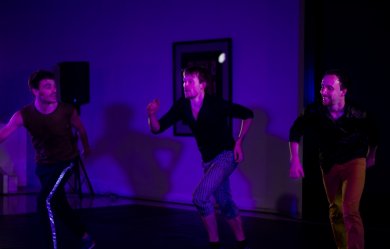 In their first "garage night", Pickle Factory - in collaboration with Kolkata Centre of Creativity and others -- presented on February 14, It's all About performed by 'CieLaroque', a frequently touring dance ensemble from Austria, under the experienced choreographic baton of Helene Weinzierl. Three male participants of the evening were Uwe Brauns, a German dancer with professional experience in contemporary dance and dance-theatre; Luan de Lima, a Brazilian dancer with extensive experience with choreographers in South America and Europe; and Alberto Cissello, an Italian dancer and dance teacher who offers "a frame of practice to anyone, regardless of technique and education". With this widely varied background, they created together, a whirlwind dancescape for the spectators. Their three bodies moved initially through space, strutting around at random, absorbed in their own inner worlds. They did not interact, but obviously there was unstated competition to judge who would last out in interplay between strength and exhaustion, speed and pause, euphoria and ennui. Movements forward and backward, frequent falls and rising again revealed a restless world that has lost all sense, all semblance of meaning and has transformed itself into a never-ending routine metaphor. Did it represent the utterly incomprehensible socio-political reality of our surrounding world? Gradually, encounters started taking place, but mostly as pas de deux. They attached themselves to each other, and then fell apart. Often, the partners were seemingly unaware of their physical links, their momentary connections, and then lost the same. Would there be a change in their reality, or would they remain hopelessly, desperately separate and secluded from each other? What kind of modernity did they represent -- of awareness and mutuality, of dreams and affection, of trust and protection, or even of life and death? 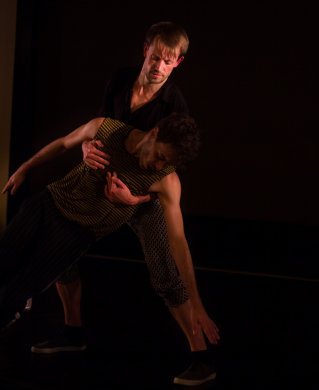 Interaction with the three dancers: Your movements were seemingly so arbitrary. How did you maintain coherence? When we begin rehearsing, our movements get gradually thought out, individually and collectively. But the final product is a well-knit choreography, completely fixed in space and time. It is eventually clearly laid down from beginning to end. Did you improvise at any stage? Actually, a lot of improvisation happens during our rehearsal process. We all participate with the choreographer and suggest scenes and sequences. But, once they fall in place, there is no scope for improvisation during the actual performance. Did you have a set text, to which you added sub-texts every now and then? Very much so. In the beginning, our choreographer set the text, for instance, drawing our attention to socio-political realities of the world we live in. We then built sub-texts, here and there, to embellish the theme and decided on the total schema. There was a lot of humor... Yes, this was deliberate: the scraping of bodies, the unintended dragging of individuals like a mannequin, the monologue going on regardless of the acute discomfort of the partner. They are all intentional, drawing attention to the utter absurdity of much of the modern life! What was the role of music? Music could be incidental and merely atmospheric, like the minimalist music you heard in the beginning. Then, music became integral, when we responded to the rhythms. It depends on individual sequences. But was there a special place for rhythms, as we have in Indian classical dance? No, not really. Generally speaking, our dance is completely a-rhythmic. Odissi Vision and Movement Centre Photos courtesy: OVM It was a delightfully laid-down garden ambience, in which OVM, under the caring nurture and guidance of Guru Sharmila Biswas, presented an evening of classical dance by three of their senior and fully groomed dancers. The evening's fare was a mix of visual and ritual dances, as was to be expected from a well-grounded group active for long years and well-honed with their national and international performing experience. Sharmila described movingly her own teaching process thus, "Guru Kelucharan taught me to dance, and with it he taught me the traditions, the rhythms, the expressions, and the nuances that enrich Odissi dance. Now as I teach, I try to follow the perspective and the philosophy of dance. I try to invent and re-invent my dance again and again....Vidya Rin is the debt one owes for acquiring the learning. It has to be paid back...The learning has to be passed on and shared with those special students with whom I have bonded for life in relationships of mutual love, respect and support. In paying back the debt, I pay homage to my Guru, to my dance, and to my beloved students..." 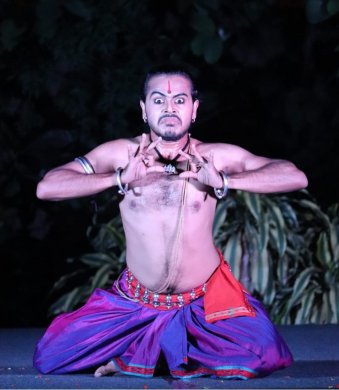 Krishnendu Saha 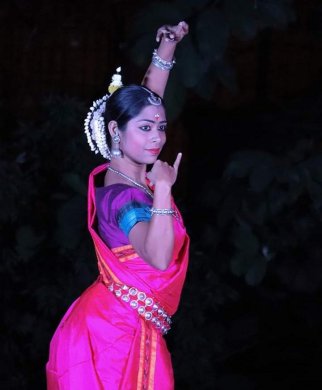 Monami Nandy Offerings, OVM's evening fare, was set off by Krishnendu Saha in a Mangalacharan, set as a ritual offering, Ramashtakam. Taking eight cardinal events in Rama's life - childhood, marriage, banishment to forest, Maricha's salvation, et al., Krishnendu illustrated them in abhinaya with delightfully precise chari, bhramari and utplavana. Monami Nandy followed next with Shiva Parbati Shabda, where she used the symbolism of the divinities to illustrate the qualities within us. Her refrain of mnemonics - Tam thoi tata thoi, Tam thoi tako thoi - and the second one - Tako ta tim thoi - went down resonantly with her abhinaya. Gati Vilas, where the trio danced together, was the tour de force of the evening. Described as a "rural midday outburst" and using direct miming, it was an out-and-out visual dance where the dancers recreated movements and gestures based on the energy of animals on the move. The running stallion, the prowling tiger, the strutting elephant and the prancing peacock - they all darted around, made patterns and each one came wonderfully alive. The penultimate item was Krishnajanma Katha, Rohini Banerjee recapturing the intimate feminine style of Oriya story-telling of Bhagavat Puran. 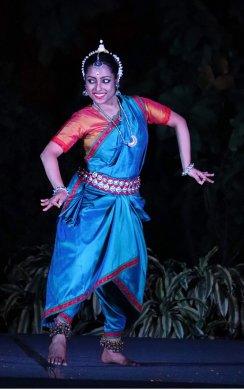 Rohini Banerjee 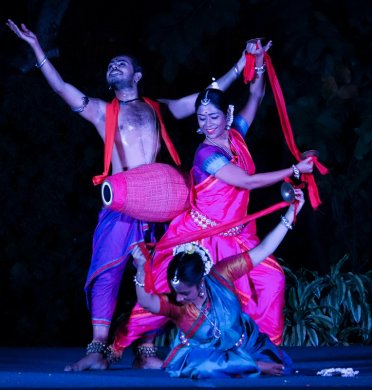 Krishnendu, Monami & Rohini In the most vivid Mukhavnaya, Rohini created the agony of Devaki in labour; the bewilderment of the imprisoned Vasudeva; the perilous journey through the surging stream; the stealthily accomplished exchange of the newborn babies; and the new father's anxious return to the prison. The agonizing encounter with and release from the ever-suspecting Agnisen - not usually brought up - was also thrown in for good measure. The grand finale was another ritual dance built around the folkloric tradition built around the genesis of their percussion instrument, mrudanga, which villagers reverentially recapitulate with musical recital of a traditional verse. Essentially a joyous group dance, the performance created a sacred ritual ambience almost lost today and resuscitated by Sharmila's painstaking research. A very satisfying evening!  Dr. Utpal K Banerjee is a scholar-commentator on performing arts over last four decades. He has authored 23 books on Indian art and culture, and 10 on Tagore studies. He served IGNCA as National Project Director, was a Tagore Research Scholar and is recipient of Padma Shri. Post your comments Please provide your name and email id when you use the Anonymous profile in the blog to post a comment. All appropriate comments posted with name and email id in the blog will also be featured in the site. |